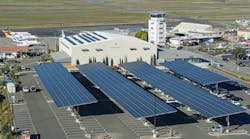Feb. 25—Sonoma County's growing regional airport will now get most of its power from the sun, after officials this week "flipped the switch" on a newly installed solar photovoltaic system that was four years in the making.
The "switch" was actually symbolic, rigged for photographs and effect. But the 884-kilowatt system did indeed start electricity to the airport this week, said Airport Manager Jon Stout.
"Power is going into the grid right now," he said.
The solar canopy piggybacks on a long-term parking area constructed in 2018. It will generate enough electricity to power the Charles M. Schultz-Sonoma County Airport even after a 35,000-square-foot terminal addition, still under construction, is completed in a little under two years, Stout said.
"Anything we can do right now to move our county toward a regenerative community is a priority right now," Sonoma County Board of Supervisors Chairman James Gore said through his District Director, Jenny Chamberlain, at a ceremony unveiling the new system Friday afternoon.
The solar system was built by ForeFront Power through a power purchase agreement that means all upfront costs were paid by the solar company, which will own and maintain the equipment.
The airport will use the solar power and, since there is no on-site storage, purchase electricity from the grid at a fixed rate of 12.9 cents per kilowatt for the 20-year duration of the agreement. But since it will generate a large surplus of energy on sunny days — enough to fully power the facility if the power were stored — it will also be credited for power it sends to the grid under the state's net-metering system.
That means it can be said to be "100% solar powered," officials said, though some of what it draws from the grid at night or when the sky is gray may not actually be sun-generated power.
In a few weeks, an online portal at flySTS.com will allow residents to see exactly how much energy is being generated at a given moment, county Sustainability Director Barbara Lee said.
Forefront also recently finished a-79 kilowatt on the roof of the county fleet building.
The combined projects will offset about 1,060 metrics tons of carbon dioxide emissions, comparable to removing about 230 passenger vehicles off the road, ForeFront Power said.
The projects, Lee said, contribute "to the county's overarching goal to be carbon neutral by 2030."
She noted that the Board of Supervisors earlier this month allocated $6.25 million for 18 climate and resilience projects around the county.
"It's a tremendous amount of work that we have ahead of us," she said.
The county airport joins a growing number of public airports around the country and the world that have adopted some degree of solar power over the last decade or so. Several international sites are fully powered by the sun through distributed microgrids.
Domestically, Chattanooga Metropolitan Airport in Tennessee, which started installing photovoltaic panels in 2011, was the first to supply 100% of its energy needs through solar power, beginning in spring 2019, with a system that generates 2.73 megawatts of electricity.
The nation's largest airport, Denver International Airport, is powered from a variety of sources but has so far built enough on-site solar equipment to provide 10 megawatts of electricity.
Tampa, Minneapolis-St. Paul, San Diego, Honolulu and Indianapolis are among dozens of other communities whose airports have begun installing solar systems.
The Sonoma County airport project is part of a continuing effort by the county to "go green," though momentum supervisors hoped to build in 2019 and '20 was diluted by the demands of the COVID pandemic.
The Sonoma County Water Agency also prides itself on providing "carbon free" water to the more than 600,000 consumers supplied by its contractors through a mix of solar, geothermal and hydropower sources that include Warm Springs Dam at Lake Sonoma.
Stout said the airport project was only possible because of the power purchase agreement. The airport operates under an enterprise fund within the county Department of Transportation and Public Works, separate from the general fund, and has a budget of about $9 million he said. The roughly $2.5 million cost of the photovoltaic system would have been out of reach had the airport had to cover it on its own, he said.
But the project still got held up for more than 1 1/2 years because early analysis by the FAA raised concerns about glare for personnel in the air traffic control tower that automatically nixed the plans. County officials kept fighting and eventually had the project greenlight after showing the "glare" was from the rising sun at two points in the year, Stout said.
The airport will have the option by the system after five years, he said. On-site storage that would allow for storage of electricity generated by the airport solar panels also might be reconsidered in three years, to see if it's a money saver then.
You can reach Staff Writer Mary Callahan at 707-521-5249 or [email protected]. On Twitter @MaryCallahanB.
___
(c)2022 The Press Democrat (Santa Rosa, Calif.)
Visit The Press Democrat (Santa Rosa, Calif.) at www.pressdemocrat.com
Distributed by Tribune Content Agency, LLC.





